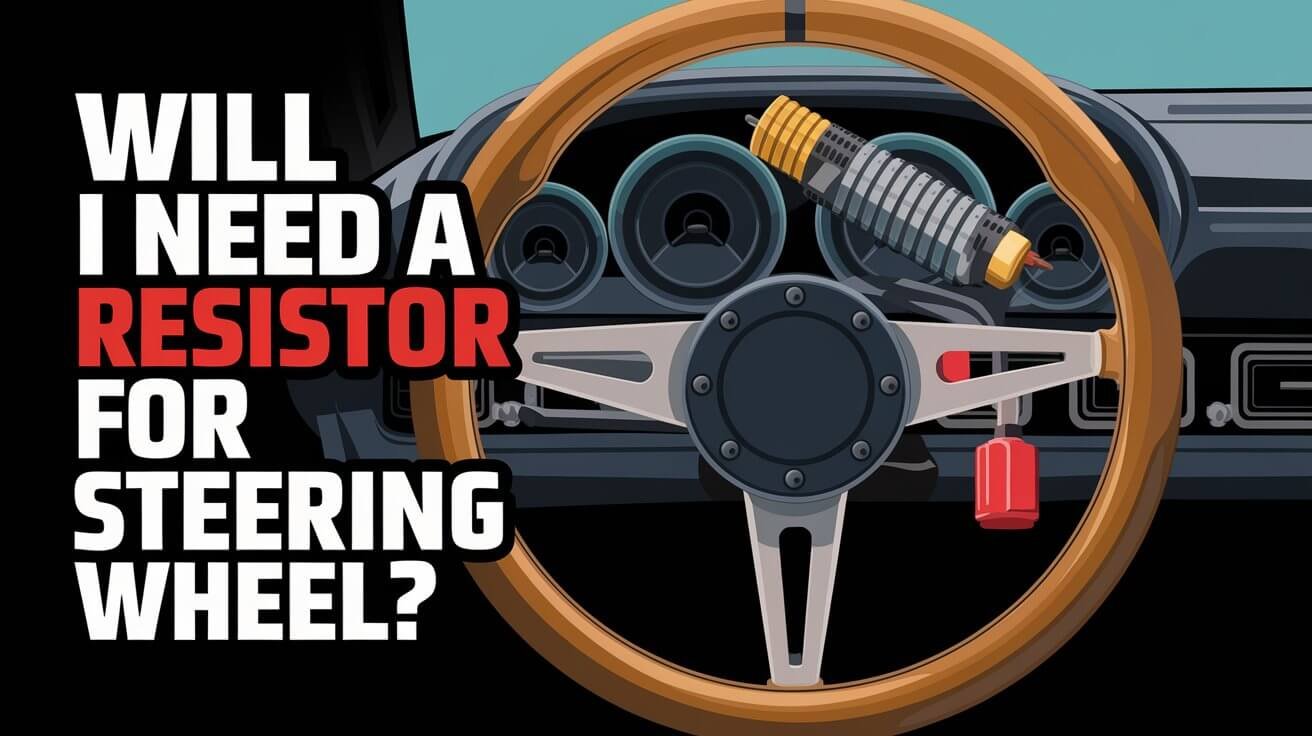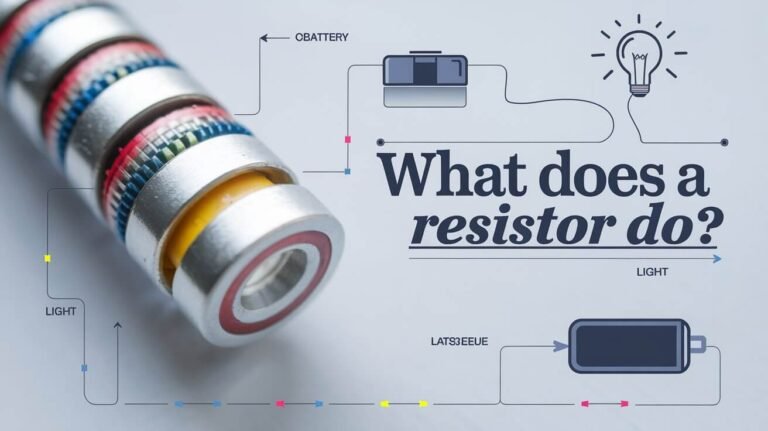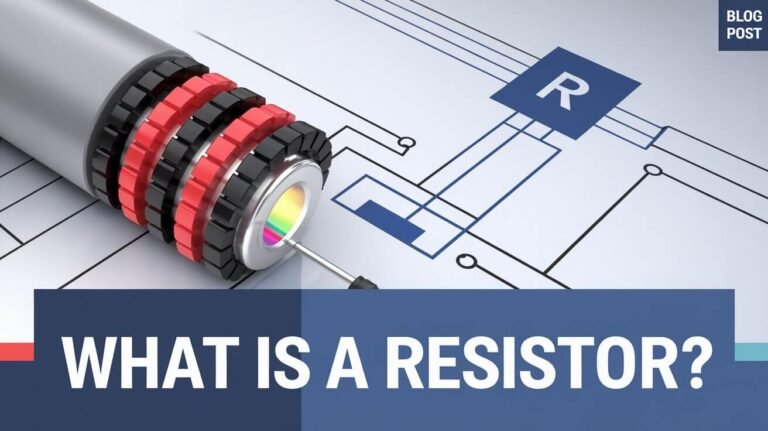
The airbag system is key to vehicle safety, and a steering wheel resistor is vital for it to work right. Sometimes, you might need a steering wheel resistor if you change or replace your steering wheel. This resistor helps send the right signal to the airbag system, making sure it works right in an accident.
Using a steering wheel resistor is important for keeping your vehicle safe. It’s often needed for certain steering wheel setups. For example, Toyota cars usually need a 2-3 Ohm resistor for the SRS airbag bypass.
The steering wheel resistor is a small but critical part. It helps avoid problems with the airbag system. Knowing about the steering wheel resistor helps car owners make smart choices for their vehicle’s upkeep and upgrades. This ensures the airbag system works as it should.
What A Steering Wheel Resistor Does
A steering wheel resistor is key in a car’s electrical systems, focusing on airbag safety. It tricks the system into thinking the airbag is connected. This is vital for cars that have been changed, keeping the airbag working right.
This resistor controls the electrical signals to the airbag. It uses specific values, like in a 2005 Pontiac GTO. These values help the airbag and other systems work well.
Signal Regulation Function
The resistor’s main job is to make sure signals to the airbag are correct and strong. This is super important for airbag safety. It helps keep the airbag system running smoothly.
Safety Features
The safety benefits of a steering wheel resistor are many. It keeps the airbag system working, which is key for safety. This is very important for cars that have been changed, adding extra protection for everyone inside.
Performance Impact
The impact of a steering wheel resistor on a car’s performance is usually small. Its main role is to manage electrical signals. But, it’s important to make sure it’s installed right to avoid any issues.
Types of Steering Wheel Resistors
There are two main types of steering wheel resistors: OEM and aftermarket. OEM resistors match a vehicle’s manufacturer specs for perfect fit and performance. Aftermarket resistors have various specs and are often cheaper.
Choosing the right resistor depends on its resistance value. For instance, a 1/2 watt 3.3 ohm resistor might work for some needs. Here’s a table showing common resistance values for steering wheel buttons:
| Button | Resistance Value (Ohm) |
|---|---|
| Mute | 284 |
| Volume Up | 164 |
| Volume Down | 82 |
| Mode | 1474 |
| Next Track | 794 |
| Previous Track | 464 |
Knowing about the different types of steering wheel resistors helps you pick the best one for your car.
Signs Your Steering Wheel Needs a Resistor
It’s vital to watch for warning signs in your vehicle’s safety features. If you’ve changed your steering wheel, the SRS light might turn on. This light warns of issues with your vehicle’s airbags and seatbelts.
You might also see problems with your steering wheel controls or other electrical issues. These problems can stem from bad wiring or missing resistance. It’s key to check your vehicle’s electrical system for damage or wear.
Airbag Warning Lights
Pay close attention to airbag warning lights if your car has them. The SRS light is usually yellow or orange and sits on your dashboard. If it lights up, get your car checked by a mechanic right away.
Control Malfunction Symptoms
Steering wheel control problems can point to bigger electrical issues. If your controls don’t work right or act up, see a mechanic. They can find the problem and fix it.
Electronic Issues
Many things can cause electrical problems, like bad wiring or missing resistance. If your car’s lights flicker or accessories don’t work, get it checked. A mechanic can find and fix the issue.
| Symptom | Possible Cause | Recommended Action |
|---|---|---|
| SRS light coming on | Problem with Supplemental Restraint System | Have vehicle inspected by a professional mechanic |
| Malfunctioning steering wheel controls | Electrical malfunction or lack of resistance | Have vehicle inspected by a professional mechanic |
| Electrical malfunctions | Improper wiring, lack of resistance, or faulty electrical component | Have vehicle inspected by a professional mechanic |
Vehicle Compatibility Factors
When checking if a vehicle fits with steering wheel resistors, several things matter. Different cars need different things for their steering systems. It’s key to look at the manufacturer’s specs to see if a resistor will work.
Some cars might need special steering systems, like airbags or electronic controls. In these cases, the resistor must match the car’s systems. For example, PAC offers Steering Wheel Interfaces for aftermarket head units, fitting some cars.
Here are important things to think about for vehicle compatibility: * Check the car’s maker specs for steering system needs * Find out if the car model works with steering wheel resistors * Think about the steering system type, like airbags or electronic controls * Look for products like PAC’s Steering Wheel Interface, which fits some cars
| Vehicle Model | Steering System Variation | Compatible Resistor |
|---|---|---|
| Toyota Camry | Airbag system | 3.3 ohm resistor |
| Honda Civic | Electronic controls | 1W resistor |
Looking at these points and checking the maker’s specs, you can see if a steering wheel resistor fits your car. This ensures it’s installed safely and right.
Will I Need a Resistor For Steering Wheel Installation
When you’re thinking about replacing your steering wheel, it’s key to check the factory settings. This helps figure out if you need to make changes to the airbag system. A resistor might be needed to keep everything working right.
For some cars, you might need a resistor when you put in a new steering wheel. It’s smart to talk to a pro to see what your car needs. They can help you install it right and make sure everything is safe.
Factory Settings Analysis
Looking closely at your car’s factory settings is important. You need to check the wiring diagram and make sure everything is connected well. Making changes to the airbag system must be done carefully and safely.
Aftermarket Modifications
Changes made to your car can sometimes cause problems with the steering wheel. A resistor might help fix these issues. Always talk to a pro to make sure everything is done right and safely.
Professional Assessment Guidelines
Getting a pro to check your car is key to knowing if you need a resistor. They can guide you on how to install it and make sure it’s done safely. This includes turning off the battery and double-checking all connections.
| Modification | Resistor Requirement | Safety Compliance |
|---|---|---|
| Steering wheel replacement | May be necessary | Ensure proper installation and connections |
| Airbag system modifications | Required for safety compliance | Follow safety regulations and guidelines |
| Aftermarket steering wheel installation | May be necessary for proper function | Consult with a professional for assessment and guidelines |
Resistor Installation Process
Installing a resistor for your steering wheel is a DIY task that needs careful steps. You must understand the wiring diagram and take safety precautions. Start by gathering tools and materials, like resistors with values like 12K, 4K7, or 18K.
It’s key to refer to the wiring diagram to find the right wires to cut and connect. Use a voltmeter to check the resistance of switches. This ensures they are in the correct range. Also, consider using aftermarket solutions like the SWI-X by Pacific Accessory Corporation for easier integration.
Important points to remember include: * Use 2-watt resistors with a 2.2 ohm resistance. * Connect resistors correctly to the steering wheel controls. * Follow the manufacturer’s guidelines for your vehicle model. * Always take safety precautions to avoid electrical shock or damage to your vehicle’s electrical system. By following these steps and being careful, you can successfully install the resistor. This will make your steering wheel control system work properly.
Common Resistor Problems and Solutions
Steering wheel resistors can face several common issues. These problems need troubleshooting and might require replacing the resistor. Electrical diagnostics are key in finding these problems.
For example, using the wrong resistor value can cause voltage problems. This can make the airbag light turn on. Replacing it with the right value, like a 3.3-ohm resistor, can fix this.
Connection issues, like loose or bad wiring, can also happen. These need a careful look and fix. Sometimes, the resistor might not work well with other car parts. This can be fixed by checking and fixing the connection problems.
Some people have fixed the SRS light by using two 2-watt 2.2ohm resistors. This works with aftermarket steering wheels, like Works Bell Hubs.
Voltage Issues
Voltage problems can come from using the wrong resistor value. This can make the steering wheel system not work right. It’s important to check the car’s manual or get help from a pro to find the right resistor value.
Connection Problems
Fixing connection issues means checking the wiring. Make sure all connections are tight. Sometimes, pictures or diagrams can help figure out the right wiring and where to put the resistor.
Compatibility Conflicts
Compatibility problems can be solved by looking up the car’s specific needs. For example, the Clio 182 might need certain resistor values or setups. Regular reset tests can help find and fix any issues after installing the resistor.
Safety Considerations When Using Steering Wheel Resistors
When you modify a vehicle’s safety system, it’s key to think about the risks. Make sure all changes follow vehicle safety standards. Using steering wheel resistors can impact airbag function. It’s important to understand this to prevent safety problems.
To stay legal, follow the maker’s rules and laws when putting in a steering wheel resistor. This means the resistor must work with your car’s airbag system. Also, all connections must be safe and secure.
Important things to think about with steering wheel resistors include:
- Make sure the resistor is installed right and connected well to avoid electrical problems
- Check that the airbag system works right after you install it
- Follow the maker’s instructions for any safety system changes
Being careful and thinking about the risks, drivers can keep their car’s safety system working right. They also make sure they follow all legal rules.
Cost Analysis of Steering Wheel Resistors
When looking at resistor pricing, it’s key to think about the long-term benefits. A steering wheel resistor is vital for a car’s electrical system. Its price can change based on its type and quality. For example, a resistor from Radio Shack can cost between $5 and $20, depending on its features.
Labor costs also affect the total price. If you can’t install it yourself, hiring a mechanic can cost $50 to $200. Yet, the cost might be worth it to avoid issues like airbag warning lights or faulty controls. This investment can protect your vehicle’s long-term value.
OEM vs Aftermarket Options
Choosing between OEM and aftermarket resistors is a big decision. OEM resistors fit your car perfectly and are guaranteed to work well. But, they are pricier. Aftermarket resistors are cheaper but might not be as reliable or compatible.
- OEM resistors: higher cost, exact specifications, and guaranteed quality
- Aftermarket resistors: lower cost, possible quality issues, and compatibility problems
Deciding between OEM and aftermarket resistors depends on your needs and budget. If you want something reliable and long-lasting, an OEM resistor is a better choice, even if it costs more. For those on a tight budget, an aftermarket resistor could be a more affordable option. Just make sure to check the manufacturer and read reviews to ensure quality.
| Resistor Type | Cost | Quality |
|---|---|---|
| OEM | $50-$100 | High |
| Aftermarket | $20-$50 | Varying |
Legal Requirements and Regulations
Modifying your vehicle’s steering wheel or airbag system must follow state laws. Vehicle inspections are key to ensuring your car is safe. In Maine, for example, you must get a new driver’s license within 30 days of moving. This includes passing a written test and a visual check at Motor Vehicle offices.
It’s important to follow your state’s Department of Motor Vehicles guidelines. In Maine, drivers under 21 need a learner’s permit for 6 months. They must also drive 70 hours, with 10 hours at night, with a licensed driver.
Some key points to consider when modifying your vehicle’s steering wheel or airbag system include:
- Always follow the manufacturer’s instructions and guidelines for any modifications.
- Ensure that all modifications meet the necessary safety standards and regulations in your state.
- Consider consulting with a professional mechanic or technician to ensure that any modifications are done correctly and safely.
Following these guidelines and considering your state’s laws, you can ensure your vehicle is safe. This is vital for vehicle inspections, as not meeting safety standards can lead to fines. Prioritizing safety and legal modifications keeps you and others safe on the road.
| State | Vehicle Inspection Requirements | Safety Certifications |
|---|---|---|
| Maine | Written exam and visual screening | Completion of a minimum of 70 hours of driving, including 10 hours of night driving |
Conclusion
When thinking about using a steering wheel resistor, remember to focus on vehicle safety. It’s key to make an informed decision. These parts are vital for your steering wheel’s correct work and the steering wheel modification systems.
Knowing the good points, possible problems, and legal rules about steering wheel resistors helps you choose wisely. This choice should fit your driving needs and keep you and your passengers safe. Always put your vehicle’s safety first when making changes or upgrades.
Looking into this, talking to a skilled car technician is a good idea. They can offer advice that fits your car and how you drive. With the right info and care, you can enjoy the benefits of a steering wheel resistor. You’ll get a more responsive and safe drive.
Most Asked Questions
What is a steering wheel resistor and why might I need one?
A steering wheel resistor is a part that helps control signals in a car’s electrical system. It’s key for the airbag to work right. If you change or replace your steering wheel, you might need one to keep the airbag system working.
How does a steering wheel resistor work?
The resistor helps manage signals in the car’s electrical system. This ensures the airbag works as it should. It’s a safety feature that keeps the airbag working even after changes to the steering wheel. It can also affect how well the car runs.
What types of steering wheel resistors are available?
There are two main types: OEM and aftermarket resistors. The 1/2 watt 3.3 ohm resistor is an example. The right one depends on your car’s make and model.
How do I know if I need a steering wheel resistor?
Signs you might need one include an SRS light that won’t turn off, or if your steering wheel controls don’t work. These problems often happen after you’ve changed your steering wheel.
Is my vehicle compatible with a steering wheel resistor?
Compatibility with a steering wheel resistor varies by car model and maker. It’s important to check if your car needs one. Different cars have different requirements for their steering systems.
How do I know if I need a resistor for my steering wheel installation?
Whether you need a resistor depends on your car’s settings and the new steering wheel. You need to check if adding a resistor is needed to keep the airbag working right. For complex cases, it’s best to get help from a professional.
How do I install a steering wheel resistor?
Installing a resistor involves cutting wires and soldering the resistor. Always follow the manufacturer’s instructions. If you’re not sure, it’s safer to get a professional to do it.
What are some common problems with steering wheel resistors?
Common issues include voltage problems and connection issues. These can be fixed by following troubleshooting steps. It’s also important to make sure the resistor works with your car’s systems.
What are the safety considerations when using a steering wheel resistor?
When you modify your car’s safety system, safety is key. Using a resistor can affect the airbag’s function. It’s important to follow safety standards and legal rules. Also, make sure any changes won’t harm your car’s safety features.
How much do steering wheel resistors cost, and what are the long-term implications?
The price of resistors varies, with OEM and aftermarket options available. Consider the cost of installation too. Using a resistor can save money in the long run by keeping your car safe and its value up.
What are the legal requirements and regulations surrounding the use of steering wheel resistors?
The laws about steering wheel resistors and airbag changes vary by state. It’s important to know the rules and safety standards. This includes how changes might affect your car’s inspection and compliance.




